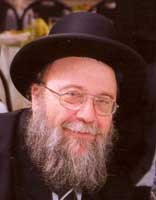Reflections
Yeshivas 'Knesses Chezkiyahu'
One of the first Lithuanian Yeshivas to be founded immediately after the establishment of the state of Israel was Yeshivas 'Knesses Chezkiyahu', and it was one of the first Torah institutions in the north of the country to spread the light of Torah to the whole region.
Rabbi Noah was joined by his brother-in-law, Rabbi David Mishkowzky, who threw himself into the task of establishing the Yeshiva. With joint efforts they succeeded in their quest and named their Yeshiva 'Knesses Chezkiyahu', after Rabbi David's father – Rabbi Chezkiyahu Yosef Mishkowzky, who had served as Rabbi of Krinik, Poland.
The original student body was comprised of only three pupils, however towards the end of the year the number had grown to thirty.
Three years after the establishment of the Yeshiva, 'Knesses Chezkiyahu' merited welcoming the renowned Rabbi Eliyahu Lopian to the Yeshiva staff. Reb Elle, as he was fondly called, was a disciple of Rabbi Simcha Zussel Zieff, the Grandfather of Kelem, and was considered father of all mashgichim (supervisors) and the leading figure of the Mussar Movement of his time. His son-in-law, Rabbi Kalman Pinski, also joined him in the Yeshiva staff. Reb Elle's immence influence on the Yeshiva was so great that it can still be felt to this very day. One of the traditions that he initiated and which is still followed today is that when one of the yeshiva students fills the washing cup to wash his hands, he refills it for the next pupil in line after he is done. The reasoning behind this was, as Reb Elle explained, that every pupil had to fill the washing cup anyway, so why not fill it for your friend and earn a Mitzvah…this tradition has spread to many other Torah institutions as well.
The fact that the Yeshiva was located within the central synagogue made it difficult for the pupils to learn. They had neither permanent sleeping arrangements nor organized meals due to the difficult financial situation in Israel at the time. Rabbi Noah's wife would stand on her feet throughout the day to provide the students with all their needs, a task she fulfills till today. The fact that the Yeshiva was located within the central synagogue, which served the local townspeople for their daily services, resulted in frequent frictions between the Yeshiva students and the local residents. This led to the decision of relocating the Yeshiva to a separate building; a decision which was later altered and exchanged for the resolution of leaving Zichron Ya'akov altogether.
When the news of the Yeshiva's quest of relocating spread and reached the orthodox communities throughout Israel, pledges from communities all over the country were made for the Yeshiva to settle in their midst. However, since most of the requests came from the center of the country, the Yeshiva management rejected them out of hand. Thus, the Yeshiva remained in its place and continued to spread the light of Torah to the surrounding villages. The opportunity the Yeshiva had been waiting for finally came when a group of community activists from the settlement of 'Kfar Hassidim' turned to the Yeshiva and offered it to relocate to Kfar Hassidim.
After receiving the Chazon Ish's blessing, the Yeshiva managers accepted the offer and began preparing for the move. With enormous efforts and at a huge expense, the management of the Yeshiva purchased a ten-dunam plot in the outskirts of the city. Five buildings were erected on the plot and contained a study hall, a dining room, and sleeping quarters of the students and the Rabbis.
In the beginning of Iyar, 5715, the Yeshiva moved into its new residence. The inauguration ceremony was planned for the 18th of Iyar – Lag B'Omer, however it was cancelled due to the unfortunate fact that the Rosh Yeshiva suffered a stroke and passed away only five days after the transfer.
Rabbi Noah's sudden passing shocked the Yeshiva students to the core and doubts concerning the continuation of the Yeshiva's existence were being heard. The Yeshiva supervisor, Reb Elle, skillfully took control over the situation and appointed Rabbi Noah's brother-in-law, Rabbi Raphael Eliyahu Eliezer Mishkowzky, as the new Rosh Yeshiva. Up until his nomination, he had served as the Rabbi of Kfar Hassidim, and the students considered the transfer to be a heaven-sent remedy for their agony.
Rabbi Raphael Eliyahu assisted Reb Elle in forming the Yeshiva and left a significant imprint in its makeup. Rabbi Raphael Eliyahu, as a Rabbi and Jewish adjudicator, was referred to as 'Harav' (the Rabbi) by the students and the local townspeople. A street in Rechasim was later named 'Derech Harav' after him.
In 5720, the Rabbi fell ill and was absent from the Yeshiva during several months. The students constantly prayed on his behalf, and in the beginning of 5721 the Rabbi recovered from his illness and returned to lecture at the Yeshiva to the students' delight.
In Sivan of 5724, the cornerstone of a new spacious building for the Yeshiva was laid, as the old buildings could no longer accommodate the many students who learned in the Yeshiva. That building still hosts the Yeshiva today.
In 5741, Rabbi Raphael Eliyahu Eliezer Mishkowzky passed away and his son-in-law, Rabbi David Yitzchak Mann, was appointed Rosh Yeshiva in his place, a position he holds to this day. Together with him in the Yeshiva management one can find Rabbi Yitzchak Bernstein, Rabbi Ovadyah Broida and Rabbi Dov Jaffe, who serves as spiritual supervisor.
As of today, the Yeshiva numbers two hundred students, an elementary Yeshiva and a Kollel for married men.






